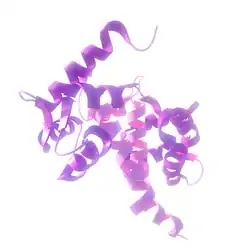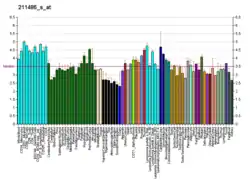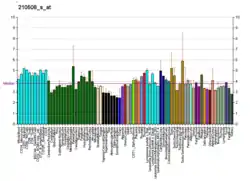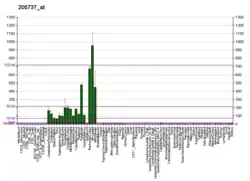KvLQT2
Kv7.2 (KvLQT2) is a volatage- and lipid-gated potassium channel protein coded for by the gene KCNQ2.
It is associated with benign familial neonatal epilepsy.
Function
The M channel is a slowly activating and deactivating potassium channel that plays a critical role in the regulation of neuronal excitability. The M channel is formed by the association of the protein encoded by this gene and a related protein encoded by the KCNQ3 gene, both integral membrane proteins. M channel currents are inhibited by M1 muscarinic acetylcholine receptors and activated by retigabine, a novel anti-convulsant drug. Defects in this gene are a cause of benign familial neonatal convulsions type 1 (BFNC), also known as epilepsy, benign neonatal type 1 (EBN1). At least five transcript variants encoding five different isoforms have been found for this gene.[5]
Ligands

.png.webp)
- ICA-069673: channel opener at KCNQ2/Q3, 20-fold selective over KCNQ3/Q5, no measurable activity against a panel of cardiac ion channels (hERG, Nav1.5, L type channels, and KCNQ1) and no activity on GABAA gated channels at 10 μM. A range of related benzamides exhibited activity, of which compound number 40 is shown here.[6]
- ML252: channel inhibitor, IC50 = 70nM.[7]
- Phosphatidylinositol 4,5-bisphosphate (PIP2)
References
- ENSG00000281151 GRCh38: Ensembl release 89: ENSG00000075043, ENSG00000281151 - Ensembl, May 2017
- GRCm38: Ensembl release 89: ENSMUSG00000016346 - Ensembl, May 2017
- "Human PubMed Reference:". National Center for Biotechnology Information, U.S. National Library of Medicine.
- "Mouse PubMed Reference:". National Center for Biotechnology Information, U.S. National Library of Medicine.
- "Entrez Gene: KCNQ2 potassium voltage-gated channel, KQT-like subfamily, member 2".
- Amato G (2011). "N -Pyridyl and Pyrimidine Benzamides as KCNQ2/Q3 Potassium Channel Openers for the Treatment of Epilepsy". ACS Medicinal Chemistry Letters. 2 (6): 481–484. doi:10.1021/ml200053x. PMC 4018159. PMID 24900334.
- Cheung YY, Yu H, Xu K, Zou B, Wu M, McManus OB, Li M, Lindsley CW, Hopkins CR (August 2012). "Discovery of a series of 2-phenyl-N-(2-(pyrrolidin-1-yl)phenyl)acetamides as novel molecular switches that modulate modes of K(v)7.2 (KCNQ2) channel pharmacology: identification of (S)-2-phenyl-N-(2-(pyrrolidin-1-yl)phenyl)butanamide (ML252) as a potent, brain penetrant K(v)7.2 channel inhibitor". Journal of Medicinal Chemistry. 55 (15): 6975–9. doi:10.1021/jm300700v. PMC 3530927. PMID 22793372.
Further reading
- Gutman GA, Chandy KG, Grissmer S, Lazdunski M, McKinnon D, Pardo LA, Robertson GA, Rudy B, Sanguinetti MC, Stühmer W, Wang X (December 2005). "International Union of Pharmacology. LIII. Nomenclature and molecular relationships of voltage-gated potassium channels". Pharmacological Reviews. 57 (4): 473–508. doi:10.1124/pr.57.4.10. PMID 16382104. S2CID 219195192.
- Yokoyama M, Nishi Y, Yoshii J, Okubo K, Matsubara K (October 1996). "Identification and cloning of neuroblastoma-specific and nerve tissue-specific genes through compiled expression profiles". DNA Research. 3 (5): 311–20. doi:10.1093/dnares/3.5.311. PMID 9039501.
- Singh NA, Charlier C, Stauffer D, DuPont BR, Leach RJ, Melis R, Ronen GM, Bjerre I, Quattlebaum T, Murphy JV, McHarg ML, Gagnon D, Rosales TO, Peiffer A, Anderson VE, Leppert M (January 1998). "A novel potassium channel gene, KCNQ2, is mutated in an inherited epilepsy of newborns". Nature Genetics. 18 (1): 25–9. doi:10.1038/ng0198-25. PMID 9425895. S2CID 30469895.
- Biervert C, Schroeder BC, Kubisch C, Berkovic SF, Propping P, Jentsch TJ, Steinlein OK (January 1998). "A potassium channel mutation in neonatal human epilepsy". Science. 279 (5349): 403–6. Bibcode:1998Sci...279..403B. doi:10.1126/science.279.5349.403. PMID 9430594.
- Yang WP, Levesque PC, Little WA, Conder ML, Ramakrishnan P, Neubauer MG, Blanar MA (July 1998). "Functional expression of two KvLQT1-related potassium channels responsible for an inherited idiopathic epilepsy". The Journal of Biological Chemistry. 273 (31): 19419–23. doi:10.1074/jbc.273.31.19419. PMID 9677360.
- Tinel N, Lauritzen I, Chouabe C, Lazdunski M, Borsotto M (November 1998). "The KCNQ2 potassium channel: splice variants, functional and developmental expression. Brain localization and comparison with KCNQ3". FEBS Letters. 438 (3): 171–6. doi:10.1016/S0014-5793(98)01296-4. PMID 9827540. S2CID 33708352.
- Wang HS, Pan Z, Shi W, Brown BS, Wymore RS, Cohen IS, Dixon JE, McKinnon D (December 1998). "KCNQ2 and KCNQ3 potassium channel subunits: molecular correlates of the M-channel". Science. 282 (5395): 1890–3. doi:10.1126/science.282.5395.1890. PMID 9836639.
- Schroeder BC, Kubisch C, Stein V, Jentsch TJ (December 1998). "Moderate loss of function of cyclic-AMP-modulated KCNQ2/KCNQ3 K+ channels causes epilepsy". Nature. 396 (6712): 687–90. Bibcode:1998Natur.396..687S. doi:10.1038/25367. PMID 9872318. S2CID 4417442.
- Biervert C, Steinlein OK (March 1999). "Structural and mutational analysis of KCNQ2, the major gene locus for benign familial neonatal convulsions". Human Genetics. 104 (3): 234–40. doi:10.1007/PL00008713. PMID 10323247. S2CID 30751027.
- Selyanko AA, Hadley JK, Wood IC, Abogadie FC, Delmas P, Buckley NJ, London B, Brown DA (September 1999). "Two types of K(+) channel subunit, Erg1 and KCNQ2/3, contribute to the M-like current in a mammalian neuronal cell" (PDF). The Journal of Neuroscience. 19 (18): 7742–56. doi:10.1523/jneurosci.19-18-07742.1999. PMC 6782456. PMID 10479678.
- Shapiro MS, Roche JP, Kaftan EJ, Cruzblanca H, Mackie K, Hille B (March 2000). "Reconstitution of muscarinic modulation of the KCNQ2/KCNQ3 K(+) channels that underlie the neuronal M current". The Journal of Neuroscience. 20 (5): 1710–21. doi:10.1523/jneurosci.20-05-01710.2000. PMC 6772928. PMID 10684873.
- Rundfeldt C, Netzer R (March 2000). "The novel anticonvulsant retigabine activates M-currents in Chinese hamster ovary-cells tranfected with human KCNQ2/3 subunits". Neuroscience Letters. 282 (1–2): 73–6. doi:10.1016/S0304-3940(00)00866-1. PMID 10713399. S2CID 28431577.
- Selyanko AA, Hadley JK, Wood IC, Abogadie FC, Jentsch TJ, Brown DA (February 2000). "Inhibition of KCNQ1-4 potassium channels expressed in mammalian cells via M1 muscarinic acetylcholine receptors". The Journal of Physiology. 522 (3): 349–55. doi:10.1111/j.1469-7793.2000.t01-2-00349.x. PMC 2269765. PMID 10713961.
- Cooper EC, Aldape KD, Abosch A, Barbaro NM, Berger MS, Peacock WS, Jan YN, Jan LY (April 2000). "Colocalization and coassembly of two human brain M-type potassium channel subunits that are mutated in epilepsy". Proceedings of the National Academy of Sciences of the United States of America. 97 (9): 4914–9. Bibcode:2000PNAS...97.4914C. doi:10.1073/pnas.090092797. PMC 18332. PMID 10781098.
- Schwake M, Pusch M, Kharkovets T, Jentsch TJ (May 2000). "Surface expression and single channel properties of KCNQ2/KCNQ3, M-type K+ channels involved in epilepsy". The Journal of Biological Chemistry. 275 (18): 13343–8. doi:10.1074/jbc.275.18.13343. PMID 10788442.
- Main MJ, Cryan JE, Dupere JR, Cox B, Clare JJ, Burbidge SA (August 2000). "Modulation of KCNQ2/3 potassium channels by the novel anticonvulsant retigabine". Molecular Pharmacology. 58 (2): 253–62. doi:10.1124/mol.58.2.253. PMID 10908292.
- Wickenden AD, Yu W, Zou A, Jegla T, Wagoner PK (September 2000). "Retigabine, a novel anti-convulsant, enhances activation of KCNQ2/Q3 potassium channels". Molecular Pharmacology. 58 (3): 591–600. doi:10.1124/mol.58.3.591. PMID 10953053.
- Tinel N, Diochot S, Lauritzen I, Barhanin J, Lazdunski M, Borsotto M (September 2000). "M-type KCNQ2-KCNQ3 potassium channels are modulated by the KCNE2 subunit". FEBS Letters. 480 (2–3): 137–41. doi:10.1016/S0014-5793(00)01918-9. PMID 11034315. S2CID 8386123.
- Smith JS, Iannotti CA, Dargis P, Christian EP, Aiyar J (February 2001). "Differential expression of kcnq2 splice variants: implications to m current function during neuronal development". The Journal of Neuroscience. 21 (4): 1096–103. doi:10.1523/jneurosci.21-04-01096.2001. PMC 6762257. PMID 11160379.
- Miraglia del Giudice E, Coppola G, Scuccimarra G, Cirillo G, Bellini G, Pascotto A (December 2000). "Benign familial neonatal convulsions (BFNC) resulting from mutation of the KCNQ2 voltage sensor". European Journal of Human Genetics. 8 (12): 994–7. doi:10.1038/sj.ejhg.5200570. PMID 11175290.
External links
- KCNQ2+Potassium+Channel at the US National Library of Medicine Medical Subject Headings (MeSH)
This article incorporates text from the United States National Library of Medicine, which is in the public domain.







